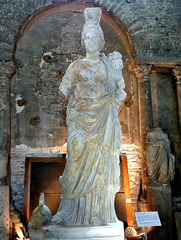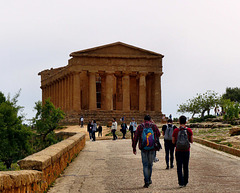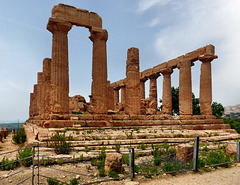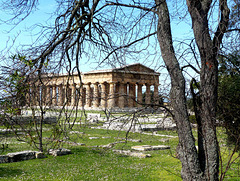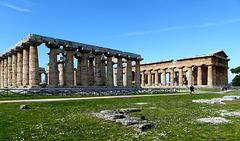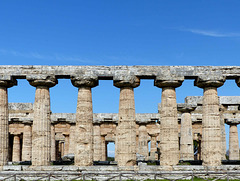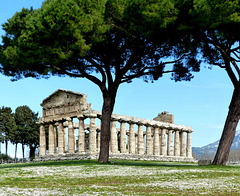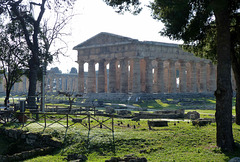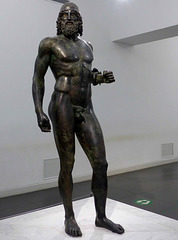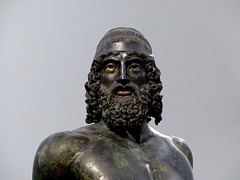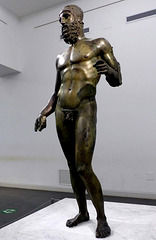
Ancient Greek and Roman Art and Architecture
Vienne - Musée archéologique Saint-Pierre de Vienn…
| |
|
The oppidum of the Celtic Alobroges became a Roman colony about 47 BC under Julius Caesar, but the Allobroges managed to expel the Romans. The exiles moved north and founded the colony of Lugdunum (today's Lyon). During the early Empire, Vienna regained all its former privileges as a Roman colony. The city flourished and became the second capital of southern Gaul during the Roman Empire.
The first Christians lived in Vienne around 100 AD. In the 3rd century, the city became a bishopric. After the death of the childless last Burgundian king Rudolf III. Vienne fell in 1032 to the German king Conrad II and thus to the Holy Roman Empire. In the 12th century, Vienne became the capital of the Dauphiné. In the 15th and 16th centuries, Vienne experienced an economic boom, numerous houses were built in the half-timbered style of the time, and the cathedral was completed. During the Wars of Religion, the city was fought over and frequently looted.
Founded in the 5th century by Bishop Mamert, the Saint-Pierre church became an abbey in the 6th century. It served as a funerary basilica until the 13th century and was then the privileged burial place of the bishops of Vienne. It is claimed that this church is one of the oldest in France. The church has retained its original basilica plan and structured nave. Monastic life ended with the French Revolution. In 1806, the city took possession of the church and set up the first municipal museum there in 1809,
Created in the late second century, "Tutela" (aka "Fortuna Tyche") was the tutelary deity of the site. The Roman marble statue was discovered in 1894.
Agrigento - Valle dei Templi
| |
|
Sicily, the largest Mediterranean island, has a long history, that starts around 8000 BC, but later there were Phoenician, Carthaginian, Greek and Roman periods. After the Roman Empire had fallen apart the Vandals tried to take over the island but failed. Finally, the Ostrogoths took possession.
Mid of the 6th century Sicily was conquered by troops of the Byzantine Empire. After the advent of Islam, Sicily got attacked by the Arab forces. Raids seeking loot continued until the mid-8th century.
A Muslim army was sent to the island in 827 but met with much resistance. So it took a century to conquer it and even later revolts constantly occurred
In 1038 the Byzantines invaded the island supported by Norman mercenaries, led by Roger. In 1072, after the siege of Palermo, most of Sicily was under Norman control. Roger´s son Roger II raised the status +of the island to a kingdom in 1130. During this period, the Kingdom of Sicily was prosperous and powerful,
The court of Roger II became melting out of culture from Europe and the Middle East. This attracted scholars, scientists, artists, and artisans. Muslims, Jews, Greeks, Lombards, and Normans cooperated and created some extraordinary buildings.
In 1186 the last descendant of Roger, Constance of Sicily married Emperor Henry VI, the second son of Barbarossa. So the crown of Sicily was passed on to the Hohenstaufen Dynasty. Frederick II, the only son of Constance, was crowned King of Sicily at the age of four in 1198. He became "Stupor Mundi", one of the greatest and most cultured men of the Middle Ages.
-
The "Valle dei Templi", located on a ridge, just south of Agrigento, is where the Greek had founded the polis "Akragas" in 532 BC. It developed into one of the most important ancient Greek cities in Sicily. This importance is still visible in a number of monumental temples, built in the 5th century BC along the southern wall of the city.
Over centuries most buildings decayed and were often used as a quarry. Excavation and restoration began mid of the 18th century when general interest in Greek antiquity arouse. So the ancient sites were attracting attention - and visitors.
The so-called "Temple of Concordia" is one of the best preserved temples of Greek antiquity.
The temple was built about 440 to 430 BC. Built on a pedestal.
The temple was converted into a Christian basilica in the 6th century and thus survived the destruction of pagan places of worship. The church was also used after the abandonment of the city until the 17th century. In 1748 the building was profaned and then largely returned to their original state. All around the temple is an early Christian necropolis.
Agrigento - Valle dei Templi
| |
|
|
|
Sicily, the largest Mediterranean island, has a long history, that starts around 8000 BC, but later there were Phoenician, Carthaginian, Greek and Roman periods. After the Roman Empire had fallen apart the Vandals tried to take over the island but failed. Finally, the Ostrogoths took possession.
Mid of the 6th century Sicily was conquered by troops of the Byzantine Empire. After the advent of Islam, Sicily got attacked by the Arab forces. Raids seeking loot continued until the mid-8th century.
A Muslim army was sent to the island in 827 but met with much resistance. So it took a century to conquer it and even later revolts constantly occurred
In 1038 the Byzantines invaded the island supported by Norman mercenaries, led by Roger. In 1072, after the siege of Palermo, most of Sicily was under Norman control. Roger´s son Roger II raised the status +of the island to a kingdom in 1130. During this period, the Kingdom of Sicily was prosperous and powerful,
The court of Roger II became melting out of culture from Europe and the Middle East. This attracted scholars, scientists, artists, and artisans. Muslims, Jews, Greeks, Lombards, and Normans cooperated and created some extraordinary buildings.
In 1186 the last descendant of Roger, Constance of Sicily married Emperor Henry VI, the second son of Barbarossa. So the crown of Sicily was passed on to the Hohenstaufen Dynasty. Frederick II, the only son of Constance, was crowned King of Sicily at the age of four in 1198. He became "Stupor Mundi", one of the greatest and most cultured men of the Middle Ages.
-
The "Valle dei Templi", located on a ridge, just south of Agrigento, is where the Greek had founded the polis "Akragas" in 532 BC. It developed into one of the most important ancient Greek cities in Sicily. This importance is still visible in a number of monumental temples, built in the 5th century BC along the southern wall of the city.
Over centuries most buildings decayed and were often used as a quarry. Excavation and restoration began mid of the 18th century when general interest in Greek antiquity arouse. So the ancient sites were attracting attention - and visitors.
The so-called "Temple of Concordia" is one of the best preserved temples of Greek antiquity.
The temple was built about 440 to 430 BC. Built on a pedestal.
The temple was converted into a Christian basilica in the 6th century and thus survived the destruction of pagan places of worship. The church was also used after the abandonment of the city until the 17th century. In 1748 the building was profaned and then largely returned to their original state. All around the temple is an early Christian necropolis.
Agrigento - Valle dei Templi
| |
|
|
Sicily, the largest Mediterranean island, has a long history, that starts around 8000 BC, but later there were Phoenician, Carthaginian, Greek and Roman periods. After the Roman Empire had fallen apart the Vandals tried to take over the island but failed. Finally, the Ostrogoths took possession.
Mid of the 6th century Sicily was conquered by troops of the Byzantine Empire. After the advent of Islam, Sicily got attacked by the Arab forces. Raids seeking loot continued until the mid-8th century.
A Muslim army was sent to the island in 827 but met with much resistance. So it took a century to conquer it and even later revolts constantly occurred
In 1038 the Byzantines invaded the island supported by Norman mercenaries, led by Roger. In 1072, after the siege of Palermo, most of Sicily was under Norman control. Roger´s son Roger II raised the status +of the island to a kingdom in 1130. During this period, the Kingdom of Sicily was prosperous and powerful,
The court of Roger II became melting out of culture from Europe and the Middle East. This attracted scholars, scientists, artists, and artisans. Muslims, Jews, Greeks, Lombards, and Normans cooperated and created some extraordinary buildings.
In 1186 the last descendant of Roger, Constance of Sicily married Emperor Henry VI, the second son of Barbarossa. So the crown of Sicily was passed on to the Hohenstaufen Dynasty. Frederick II, the only son of Constance, was crowned King of Sicily at the age of four in 1198. He became "Stupor Mundi", one of the greatest and most cultured men of the Middle Ages.
-
The "Valle dei Templi", located on a ridge, just south of Agrigento, is where the Greek had founded the polis "Akragas" in 532 BC. It developed into one of the most important ancient Greek cities in Sicily. This importance is still visible in a number of monumental temples, built in the 5th century BC along the southern wall of the city.
Over centuries most buildings decayed and were often used as a quarry. Excavation and restoration began mid of the 18th century when general interest in Greek antiquity arouse. So the ancient sites were attracting attention - and visitors.
The so-called "Temple of Concordia" is one of the best preserved temples of Greek antiquity.
The temple was built about 440 to 430 BC. Built on a pedestal.
The temple was converted into a Christian basilica in the 6th century and thus survived the destruction of pagan places of worship. The church was also used after the abandonment of the city until the 17th century. In 1748 the building was profaned and then largely returned to their original state. All around the temple is an early Christian necropolis.
Agrigento - Valle dei Templi
| |
|
|
Sicily, the largest Mediterranean island, has a long history, that starts around 8000 BC, but later there were Phoenician, Carthaginian, Greek and Roman periods. After the Roman Empire had fallen apart the Vandals tried to take over the island but failed. Finally, the Ostrogoths took possession.
Mid of the 6th century Sicily was conquered by troops of the Byzantine Empire. After the advent of Islam, Sicily got attacked by the Arab forces. Raids seeking loot continued until the mid-8th century.
A Muslim army was sent to the island in 827 but met with much resistance. So it took a century to conquer it and even later revolts constantly occurred
In 1038 the Byzantines invaded the island supported by Norman mercenaries, led by Roger. In 1072, after the siege of Palermo, most of Sicily was under Norman control. Roger´s son Roger II raised the status +of the island to a kingdom in 1130. During this period, the Kingdom of Sicily was prosperous and powerful,
The court of Roger II became melting out of culture from Europe and the Middle East. This attracted scholars, scientists, artists, and artisans. Muslims, Jews, Greeks, Lombards, and Normans cooperated and created some extraordinary buildings.
In 1186 the last descendant of Roger, Constance of Sicily married Emperor Henry VI, the second son of Barbarossa. So the crown of Sicily was passed on to the Hohenstaufen Dynasty. Frederick II, the only son of Constance, was crowned King of Sicily at the age of four in 1198. He became "Stupor Mundi", one of the greatest and most cultured men of the Middle Ages.
-
The "Valle dei Templi", located on a ridge, just south of Agrigento, is where the Greek had founded the polis "Akragas" in 532 BC. It developed into one of the most important ancient Greek cities in Sicily. This importance is still visible in a number of monumental temples, built in the 5th century BC along the southern wall of the city.
Over centuries most buildings decayed and were often used as a quarry. Excavation and restoration began mid of the 18th century when general interest in Greek antiquity arouse. So the ancient sites were attracting attention - and visitors.
The Archeological Park extends over 1300 hectares and is declared a UNESCO World Heritage Site since 1997. The greek polis developed in terraces and had a regular urban plan. In the 6th century BC, a massive defence wall, 12 kilometres long with 9 gates was built around Akragas.
The city flourished but got destroyed by the Carthaginians in 406BC. Later it got "refounded" by Greek settlers, but played a role during the Punic wars, when the Carthaginians had a base here. In 210 BC the Romans conquered it and named it Agrigentum.
Agrigento - Valle dei Templi
| |
|
Sicily, the largest Mediterranean island, has a long history, that starts around 8000 BC, but later there were Phoenician, Carthaginian, Greek and Roman periods. After the Roman Empire had fallen apart the Vandals tried to take over the island but failed. Finally, the Ostrogoths took possession.
Mid of the 6th century Sicily was conquered by troops of the Byzantine Empire. After the advent of Islam, Sicily got attacked by the Arab forces. Raids seeking loot continued until the mid-8th century.
A Muslim army was sent to the island in 827 but met with much resistance. So it took a century to conquer it and even later revolts constantly occurred
In 1038 the Byzantines invaded the island supported by Norman mercenaries, led by Roger. In 1072, after the siege of Palermo, most of Sicily was under Norman control. Roger´s son Roger II raised the status +of the island to a kingdom in 1130. During this period, the Kingdom of Sicily was prosperous and powerful,
The court of Roger II became melting out of culture from Europe and the Middle East. This attracted scholars, scientists, artists, and artisans. Muslims, Jews, Greeks, Lombards, and Normans cooperated and created some extraordinary buildings.
In 1186 the last descendant of Roger, Constance of Sicily married Emperor Henry VI, the second son of Barbarossa. So the crown of Sicily was passed on to the Hohenstaufen Dynasty. Frederick II, the only son of Constance, was crowned King of Sicily at the age of four in 1198. He became "Stupor Mundi", one of the greatest and most cultured men of the Middle Ages.
-
The "Valle dei Templi", located on a ridge, just south of Agrigento, is where the Greek had founded the polis "Akragas" in 532 BC. It developed into one of the most important ancient Greek cities in Sicily. This importance is still visible in a number of monumental temples, built in the 5th century BC along the southern wall of the city.
Over centuries most buildings decayed and were often used as a quarry. Excavation and restoration began mid of the 18th century when general interest in Greek antiquity arouse. So the ancient sites were attracting attention - and visitors.
Today the Archeological Park extends over 1300 hectares and is declared a UNESCO World Heritage Site since 1997. The greek polis developed in terraces and had a regular urban plan. In the 6th century BC, a massive defence wall, 12 kilometres long with 9 gates was built around Akragas.
The city flourished but got destroyed by the Carthaginians in 406BC. Later it got "refounded" by Greek settlers, but played a role during the Punic wars, when the Carthaginians had a base here. In 210 BC the Romans conquered it and named it Agrigentum.
Agrigento - Valle dei Templi
| |
|
|
Sicily, the largest Mediterranean island, has a long history, that starts around 8000 BC, but later there were Phoenician, Carthaginian, Greek and Roman periods. After the Roman Empire had fallen apart the Vandals tried to take over the island but failed. Finally, the Ostrogoths took possession.
Mid of the 6th century Sicily was conquered by troops of the Byzantine Empire. After the advent of Islam, Sicily got attacked by the Arab forces. Raids seeking loot continued until the mid-8th century.
A Muslim army was sent to the island in 827 but met with much resistance. So it took a century to conquer it and even later revolts constantly occurred
In 1038 the Byzantines invaded the island supported by Norman mercenaries, led by Roger. In 1072, after the siege of Palermo, most of Sicily was under Norman control. Roger´s son Roger II raised the status +of the island to a kingdom in 1130. During this period, the Kingdom of Sicily was prosperous and powerful,
The court of Roger II became melting out of culture from Europe and the Middle East. This attracted scholars, scientists, artists, and artisans. Muslims, Jews, Greeks, Lombards, and Normans cooperated and created some extraordinary buildings.
In 1186 the last descendant of Roger, Constance of Sicily married Emperor Henry VI, the second son of Barbarossa. So the crown of Sicily was passed on to the Hohenstaufen Dynasty. Frederick II, the only son of Constance, was crowned King of Sicily at the age of four in 1198. He became "Stupor Mundi", one of the greatest and most cultured men of the Middle Ages.
-
The "Valle dei Templi", located on a ridge, just south of Agrigento, is where the Greek had founded the polis "Akragas" in 532 BC. It developed into one of the most important ancient Greek cities in Sicily. This importance is still visible in a number of monumental temples, built in the 5th century BC along the southern wall of the city.
Over centuries most buildings decayed and were often used as a quarry. Excavation and restoration began mid of the 18th century when general interest in Greek antiquity arouse. So the ancient sites were attracting attention - and visitors.
Today the Archeological Park extends over 1300 hectares and is declared a UNESCO World Heritage Site since 1997. The greek polis developed in terraces and had a regular urban plan. In the 6th century BC, a massive defence wall, 12 kilometres long with 9 gates was built around Akragas.
The city flourished but got destroyed by the Carthaginians in 406BC. Later it got "refounded" by Greek settlers, but played a role during the Punic wars, when the Carthaginians had a base here. In 210 BC the Romans conquered it and named it Agrigentum.
The "Temple of Zeus", mentioned in ancient texts, was the largest Doric temple in the western Greek world. The ruins, visible today, are what survived of the destruction in ancient and modern times, when the stone blocks from the temple were used as building material. The roofs of the temple were omce supported by giant atlasses. One of them stretches on the ground now.
Agrigento - Valle dei Templi
| |
|
Sicily, the largest Mediterranean island, has a long history, that starts around 8000 BC, but later there were Phoenician, Carthaginian, Greek and Roman periods. After the Roman Empire had fallen apart the Vandals tried to take over the island but failed. Finally, the Ostrogoths took possession.
Mid of the 6th century Sicily was conquered by troops of the Byzantine Empire. After the advent of Islam, Sicily got attacked by the Arab forces. Raids seeking loot continued until the mid-8th century.
A Muslim army was sent to the island in 827 but met with much resistance. So it took a century to conquer it and even later revolts constantly occurred
In 1038 the Byzantines invaded the island supported by Norman mercenaries, led by Roger. In 1072, after the siege of Palermo, most of Sicily was under Norman control. Roger´s son Roger II raised the status +of the island to a kingdom in 1130. During this period, the Kingdom of Sicily was prosperous and powerful,
The court of Roger II became melting out of culture from Europe and the Middle East. This attracted scholars, scientists, artists, and artisans. Muslims, Jews, Greeks, Lombards, and Normans cooperated and created some extraordinary buildings.
In 1186 the last descendant of Roger, Constance of Sicily married Emperor Henry VI, the second son of Barbarossa. So the crown of Sicily was passed on to the Hohenstaufen Dynasty. Frederick II, the only son of Constance, was crowned King of Sicily at the age of four in 1198. He became "Stupor Mundi", one of the greatest and most cultured men of the Middle Ages.
-
The "Valle dei Templi", located on a ridge, just south of Agrigento, is where the Greek had founded the polis "Akragas" in 532 BC. It developed into one of the most important ancient Greek cities in Sicily. This importance is still visible in a number of monumental temples, built in the 5th century BC along the southern wall of the city.
Over centuries most buildings decayed and were often used as a quarry. Excavation and restoration began mid of the 18th century when general interest in Greek antiquity arouse. So the ancient sites were attracting attention - and visitors.
Today the Archeological Park extends over 1300 hectares and is declared a UNESCO World Heritage Site since 1997. The greek polis developed in terraces and had a regular urban plan. In the 6th century BC, a massive defence wall, 12 kilometres long with 9 gates was built around Akragas.
The city flourished but got destroyed by the Carthaginians in 406BC. Later it got "refounded" by Greek settlers, but played a role during the Punic wars, when the Carthaginians had a base here. In 210 BC the Romans conquered it and named it Agrigentum.
Syracuse - Tempio di Apollo
| |
|
Sicily, the largest Mediterranean island, has a long history, that starts around 8000 BC, but later there were Phoenician, Carthaginian, Greek and Roman periods. After the Roman Empire had fallen apart the Vandals tried to take over the island but failed. Finally, the Ostrogoths took possession.
Mid of the 6th century Sicily was conquered by troops of the Byzantine Empire. After the advent of Islam, Sicily got attacked by the Arab forces. Raids seeking loot continued until the mid-8th century.
A Muslim army was sent to the island in 827 but met with much resistance. So it took a century to conquer it and even later revolts constantly occurred
In 1038 the Byzantines invaded the island supported by Norman mercenaries, led by Roger. In 1072, after the siege of Palermo, most of Sicily was under Norman control. Roger´s son Roger II raised the status +of the island to a kingdom in 1130. During this period, the Kingdom of Sicily was prosperous and powerful,
The court of Roger II became melting out of culture from Europe and the Middle East. This attracted scholars, scientists, artists, and artisans. Muslims, Jews, Greeks, Lombards, and Normans cooperated and created some extraordinary buildings.
In 1186 the last descendant of Roger, Constance of Sicily married Emperor Henry VI, the second son of Barbarossa. So the crown of Sicily was passed on to the Hohenstaufen Dynasty. Frederick II, the only son of Constance, was crowned King of Sicily at the age of four in 1198. He became "Stupor Mundi", one of the greatest and most cultured men of the Middle Ages.
-
Syracuse, founded by Greek settlers in 734 BC, developed into the most powerful city on the island in the early times. Syracuse withstood the attacks of foreign conquerors over a long period, but in 212 BC it became a Roman city. After the fall of the Roman Empire, Syracuse came under the rule of the Vandals and then the Ostrogoths. Then for three centuries, Syracuse was part of the Byzantine Empire, before the Arabs conquered the city in 878. In 1038 Byzantine troops took over and the "Castello Maniace" was erected. Already in 1086 Roger I sieged Syracuse and conquered the city. In 1221 Emperor Frederick II took over and had the Castello Maniace rebuilt.
-
Syracuse´s historical centre ("Città Vecchia") is located on the small island of Ortyga, where the Greek settlers built the "Temple of Apollo" at the beginning of the 6th century BC. This is the oldest known Greek temple in Sicily.
Paestum - Hera II
| |
|
|
The city was founded under the name of Poseidonia around 600 BC. founded by Greeks and was part of "Magna Graecia". The extensive trade led to prosperity which spread in the 5th and 6th centuries BC. expressed in the construction of large temples.
Around 270 BC the city became a Latin colonia under the name of Paestum. During the Roman Empire, Paestum lost prosperity and importance. Around 500 AD the area began to silt up and become swampy, malaria spread, and the last inhabitants left the place. The temple complex turned into a kind of jungle, and the place was forgotten. After being destroyed by the Saracens and by the Normans, Paestum was abandoned. An early map showed the ruins in 1732. The rediscovery happened parallel to Pompeii and Herculaneum. An expedition into the enchanted swamp landscape was soon part of the program for the so-called Grand Tour.
The ancient city was surrounded by defensive walls. The area is clear of modern buildings and has been largely so, since the Middle Ages. Although much stone has been stripped from the site, large numbers of buildings remain detectable by their footings or the lower parts of their walls.
Best preserved are the large three Greek Temples. Seen here is the second temple of Hera (Hera II), constructed ca. 450 BC.
Paestum - Hera Temples
| |
|
|
The city was founded under the name of Poseidonia around 600 BC. founded by Greeks and was part of "Magna Graecia". The extensive trade led to prosperity which spread in the 5th and 6th centuries BC. expressed in the construction of large temples.
Around 270 BC the city became a Latin colonia under the name of Paestum. During the Roman Empire, Paestum lost prosperity and importance. Around 500 AD the area began to silt up and become swampy, malaria spread, and the last inhabitants left the place. The temple complex turned into a kind of jungle, and the place was forgotten. After being destroyed by the Saracens and by the Normans, Paestum was abandoned. An early map showed the ruins in 1732. The rediscovery happened parallel to Pompeii and Herculaneum. An expedition into the enchanted swamp landscape was soon part of the program for the so-called Grand Tour.
The ancient city was surrounded by defensive walls. The area is clear of modern buildings and has been largely so, since the Middle Ages. Although much stone has been stripped from the site, large numbers of buildings remain detectable by their footings or the lower parts of their walls.
The three large Greek temples are the best preserved. Here are the two Hera temples. Hera I (ca. 550 BC) on the left, Hera II (ca. 450 BC) on the right.
Paestum - Hera I
| |
|
|
The city was founded under the name of Poseidonia around 600 BC. founded by Greeks and was part of "Magna Graecia". The extensive trade led to prosperity which spread in the 5th and 6th centuries BC. expressed in the construction of large temples.
Around 270 BC the city became a Latin colonia under the name of Paestum. During the Roman Empire, Paestum lost prosperity and importance. Around 500 AD the area began to silt up and become swampy, malaria spread, and the last inhabitants left the place. The temple complex turned into a kind of jungle, and the place was forgotten. After being destroyed by the Saracens and by the Normans, Paestum was abandoned. An early map showed the ruins in 1732. The rediscovery happened parallel to Pompeii and Herculaneum. An expedition into the enchanted swamp landscape was soon part of the program for the so-called Grand Tour.
The ancient city was surrounded by defensive walls. The area is clear of modern buildings and has been largely so, since the Middle Ages. Although much stone has been stripped from the site, large numbers of buildings remain detectable by their footings or the lower parts of their walls.
The three large Greek temples are the best preserved.
Hera I (ca. 550 BC)
Paestum - Temple of Athena
| |
|
|
The city was founded under the name of Poseidonia around 600 BC. founded by Greeks and was part of "Magna Graecia". The extensive trade led to prosperity which spread in the 5th and 6th centuries BC. expressed in the construction of large temples.
Around 270 BC the city became a Latin colonia under the name of Paestum. During the Roman Empire, Paestum lost prosperity and importance. Around 500 AD the area began to silt up and become swampy, malaria spread, and the last inhabitants left the place. The temple complex turned into a kind of jungle, and the place was forgotten. After being destroyed by the Saracens and by the Normans, Paestum was abandoned. An early map showed the ruins in 1732. The rediscovery happened parallel to Pompeii and Herculaneum. An expedition into the enchanted swamp landscape was soon part of the program for the so-called Grand Tour.
The ancient city was surrounded by defensive walls. The area is clear of modern buildings and has been largely so, since the Middle Ages. Although much stone has been stripped from the site, large numbers of buildings remain detectable by their footings or the lower parts of their walls.
The three large Greek temples are the best preserved.
The Temple of Athena (ca 500 BC.). The temple may have been used as a Christian church, as three Christian graves have been found inside.
Paestum - Hera Temples
| |
|
|
The city was founded under the name of Poseidonia around 600 BC. founded by Greeks and was part of "Magna Graecia". The extensive trade led to prosperity which spread in the 5th and 6th centuries BC. expressed in the construction of large temples.
Around 270 BC the city became a Latin colonia under the name of Paestum. During the Roman Empire, Paestum lost prosperity and importance. Around 500 AD the area began to silt up and become swampy, malaria spread, and the last inhabitants left the place. The temple complex turned into a kind of jungle, and the place was forgotten. After being destroyed by the Saracens and by the Normans, Paestum was abandoned. An early map showed the ruins in 1732. The rediscovery happened parallel to Pompeii and Herculaneum. An expedition into the enchanted swamp landscape was soon part of the program for the so-called Grand Tour.
The ancient city was surrounded by defensive walls. The area is clear of modern buildings and has been largely so, since the Middle Ages. Although much stone has been stripped from the site, large numbers of buildings remain detectable by their footings or the lower parts of their walls.
The three large Greek temples are the best preserved. Here are the two Hera temples. Hera I (ca. 550 BC) on the left, Hera II (ca. 450 BC) on the right.
Reggio Calabria - Museo Archeologico Nazionale Di…
| |
|
Reggio Calabria is the largest city in Calabria. It has an estimated population of nearly 200,000. Reggio is the oldest city in the region, and during ancient times, it was an important and flourishing colony of Magna Graecia. It is separated from the island of Sicily by the Strait of Messina. Today Reggio has a modern urban system, set up after the catastrophic earthquake of 1908, which destroyed most of the city. The seismicity is caused by Reggio being on the Eurasian Plate near the faultline where it meets the African Plate that runs through the strait, dividing the two European regions of Calabria and Sicily into two different tectonic regions.
Reggio, located opposite Messina, always had strategic importance. Invasions by the Vandals, the Lombards, and the Goths occurred in the 5th–6th centuries. Then, under Byzantine rule, it became a metropolis of Byzantine possessions in Italy. Until the 15th century, Reggio was one of the most important Greek-rite Bishoprics in Italy. The Arabs occupied Reggio in 918. For brief periods in the 10th–11th centuries, the city was ruled by the Arabs and it became part of the Emirate of Sicily. In 1005, a Christian fleet coming from Pisa sacked the city and massacred all the Saracens to the great jubilation of the local population. In 1060 the Normans, under Robert Guiscard and Roger I of Sicily, captured Reggio. In 1194 Reggio and the whole of southern Italy went to the Hohenstaufen, who held it until 1266. In 1234 the town fair was established by decree of King Frederick II.
The Palazzo Piacentini houses the fantastic "Museo Archeologico Nazionale Di Reggio Calabria" aka "Museo Nazionale della Magna Grecia".
The two most famous inhabitants of the museum are the "Riace Bronzes" aka "Riace Warriors".
These are two full-size Greek bronzes of naked bearded warriors, cast about 460–450 BC that were found in the sea in 1972 near Riace. Although the bronzes were rediscovered in 1972, they did not emerge from conservation until 1981. Considered one of the symbols of Calabria, the bronzes were commemorated even by a pair of Italian postage stamps. Both sculptures were made using the lost wax casting technique.
There is still debate on who found the statues. Either Roman Stefano Mariottini chanced upon the bronzes while snorkeling some 200 meters from the coast of Riace. Or they were found by four young teenagers from Riacef. Having found the statues underwater, they went to the government finances office and declared their find.
At the time the sculptures were made much of Calabria was part of Magna Graecia.
The Riace bronzes are surviving examples of ancient Greek sculpture. Their musculature is clear, yet not incised, and looks soft enough to be visible and realistic. The bronzes' turned heads add life to the figures. Their lips and nipples are made of copper. At one time, they held spears and shields, but those have not been found.
Reggio Calabria - Museo Archeologico Nazionale Di…
| |
|
Reggio Calabria is the largest city in Calabria. It has an estimated population of nearly 200,000. Reggio is the oldest city in the region, and during ancient times, it was an important and flourishing colony of Magna Graecia. It is separated from the island of Sicily by the Strait of Messina. Today Reggio has a modern urban system, set up after the catastrophic earthquake of 1908, which destroyed most of the city. The seismicity is caused by Reggio being on the Eurasian Plate near the faultline where it meets the African Plate that runs through the strait, dividing the two European regions of Calabria and Sicily into two different tectonic regions.
Reggio, located opposite Messina, always had strategic importance. Invasions by the Vandals, the Lombards, and the Goths occurred in the 5th–6th centuries. Then, under Byzantine rule, it became a metropolis of Byzantine possessions in Italy. Until the 15th century, Reggio was one of the most important Greek-rite Bishoprics in Italy. The Arabs occupied Reggio in 918. For brief periods in the 10th–11th centuries, the city was ruled by the Arabs and it became part of the Emirate of Sicily. In 1005, a Christian fleet coming from Pisa sacked the city and massacred all the Saracens to the great jubilation of the local population. In 1060 the Normans, under Robert Guiscard and Roger I of Sicily, captured Reggio. In 1194 Reggio and the whole of southern Italy went to the Hohenstaufen, who held it until 1266. In 1234 the town fair was established by decree of King Frederick II.
The Palazzo Piacentini houses the fantastic "Museo Archeologico Nazionale Di Reggio Calabria" aka "Museo Nazionale della Magna Grecia".
The two most famous inhabitants of the museum are the "Riace Bronzes" aka "Riace Warriors".
These are two full-size Greek bronzes of naked bearded warriors, cast about 460–450 BC that were found in the sea in 1972 near Riace. Although the bronzes were rediscovered in 1972, they did not emerge from conservation until 1981. Considered one of the symbols of Calabria, the bronzes were commemorated even by a pair of Italian postage stamps. Both sculptures were made using the lost wax casting technique.
There is still debate on who found the statues. Either Roman Stefano Mariottini chanced upon the bronzes while snorkeling some 200 meters from the coast of Riace. Or they were found by four young teenagers from Riacef. Having found the statues underwater, they went to the government finances office and declared their find.
At the time the sculptures were made much of Calabria was part of Magna Graecia.
The Riace bronzes are surviving examples of ancient Greek sculpture. Their musculature is clear, yet not incised, and looks soft enough to be visible and realistic. The bronzes' turned heads add life to the figures. Their lips and nipples are made of copper. At one time, they held spears and shields, but those have not been found.
Reggio Calabria - Museo Archeologico Nazionale Di…
| |
|
Reggio Calabria is the largest city in Calabria. It has an estimated population of nearly 200,000. Reggio is the oldest city in the region, and during ancient times, it was an important and flourishing colony of Magna Graecia. It is separated from the island of Sicily by the Strait of Messina. Today Reggio has a modern urban system, set up after the catastrophic earthquake of 1908, which destroyed most of the city. The seismicity is caused by Reggio being on the Eurasian Plate near the faultline where it meets the African Plate that runs through the strait, dividing the two European regions of Calabria and Sicily into two different tectonic regions.
Reggio, located opposite Messina, always had strategic importance. Invasions by the Vandals, the Lombards, and the Goths occurred in the 5th–6th centuries. Then, under Byzantine rule, it became a metropolis of Byzantine possessions in Italy. Until the 15th century, Reggio was one of the most important Greek-rite Bishoprics in Italy. The Arabs occupied Reggio in 918. For brief periods in the 10th–11th centuries, the city was ruled by the Arabs and it became part of the Emirate of Sicily. In 1005, a Christian fleet coming from Pisa sacked the city and massacred all the Saracens to the great jubilation of the local population. In 1060 the Normans, under Robert Guiscard and Roger I of Sicily, captured Reggio. In 1194 Reggio and the whole of southern Italy went to the Hohenstaufen, who held it until 1266. In 1234 the town fair was established by decree of King Frederick II.
The Palazzo Piacentini houses the fantastic "Museo Archeologico Nazionale Di Reggio Calabria" aka "Museo Nazionale della Magna Grecia".
The two most famous inhabitants of the museum are the "Riace Bronzes" aka "Riace Warriors".
These are two full-size Greek bronzes of naked bearded warriors, cast about 460–450 BC that were found in the sea in 1972 near Riace. Although the bronzes were rediscovered in 1972, they did not emerge from conservation until 1981. Considered one of the symbols of Calabria, the bronzes were commemorated even by a pair of Italian postage stamps. Both sculptures were made using the lost wax casting technique.
There is still debate on who found the statues. Either Roman Stefano Mariottini chanced upon the bronzes while snorkeling some 200 meters from the coast of Riace. Or they were found by four young teenagers from Riacef. Having found the statues underwater, they went to the government finances office and declared their find.
At the time the sculptures were made much of Calabria was part of Magna Graecia.
The Riace bronzes are surviving examples of ancient Greek sculpture. Their musculature is clear, yet not incised, and looks soft enough to be visible and realistic. The bronzes' turned heads add life to the figures. Their lips and nipples are made of copper. At one time, they held spears and shields, but those have not been found.
Reggio Calabria - Museo Archeologico Nazionale Di…
| |
|
Reggio Calabria is the largest city in Calabria. It has an estimated population of nearly 200,000. Reggio is the oldest city in the region, and during ancient times, it was an important and flourishing colony of Magna Graecia. It is separated from the island of Sicily by the Strait of Messina. Today Reggio has a modern urban system, set up after the catastrophic earthquake of 1908, which destroyed most of the city. The seismicity is caused by Reggio being on the Eurasian Plate near the faultline where it meets the African Plate that runs through the strait, dividing the two European regions of Calabria and Sicily into two different tectonic regions.
Reggio, located opposite Messina, always had strategic importance. Invasions by the Vandals, the Lombards, and the Goths occurred in the 5th–6th centuries. Then, under Byzantine rule, it became a metropolis of Byzantine possessions in Italy. Until the 15th century, Reggio was one of the most important Greek-rite Bishoprics in Italy. The Arabs occupied Reggio in 918. For brief periods in the 10th–11th centuries, the city was ruled by the Arabs and it became part of the Emirate of Sicily. In 1005, a Christian fleet coming from Pisa sacked the city and massacred all the Saracens to the great jubilation of the local population. In 1060 the Normans, under Robert Guiscard and Roger I of Sicily, captured Reggio. In 1194 Reggio and the whole of southern Italy went to the Hohenstaufen, who held it until 1266. In 1234 the town fair was established by decree of King Frederick II.
The Palazzo Piacentini houses the fantastic "Museo Archeologico Nazionale Di Reggio Calabria" aka "Museo Nazionale della Magna Grecia".
The two most famous inhabitants of the museum are the "Riace Bronzes" aka "Riace Warriors".
These are two full-size Greek bronzes of naked bearded warriors, cast about 460–450 BC that were found in the sea in 1972 near Riace. Although the bronzes were rediscovered in 1972, they did not emerge from conservation until 1981. Considered one of the symbols of Calabria, the bronzes were commemorated even by a pair of Italian postage stamps. Both sculptures were made using the lost wax casting technique.
There is still debate on who found the statues. Either a Roman tourist chanced upon the bronzes while snorkeling some 200 meters from the coast of Riace. Or they were found by four young teenagers from Riacef. Having found the statues underwater, they went to the government finances office and declared their find.
At the time the sculptures were made much of Calabria was part of Magna Graecia.
The Riace bronzes are surviving examples of ancient Greek sculpture. Their musculature is clear, yet not incised, and looks soft enough to be visible and realistic. The bronzes' turned heads add life to the figures. Their lips and nipples are made of copper. At one time, they held spears and shields, but those have not been found.
Jump to top
RSS feed- Latest items - Subscribe to the latest items added to this album
- ipernity © 2007-2024
- Help & Contact
|
Club news
|
About ipernity
|
History |
ipernity Club & Prices |
Guide of good conduct
Donate | Group guidelines | Privacy policy | Terms of use | Statutes | In memoria -
Facebook
Twitter

